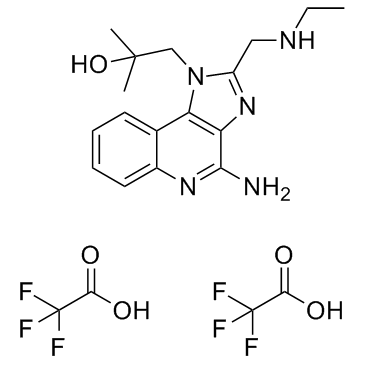| Cas No.: | 1159840-61-5 |
| Chemical Name: | Gardiquimod TFA |
| Synonyms: | Gardiquimod TFA salt; Gardiquimod; |
| SMILES: | CC(O)(C)CN1C(CNCC)=NC2=C1C3=CC=CC=C3N=C2N.O=C(O)C(F)(F)F |
| Formula: | C19H24F3N5O3 |
| M.Wt: | 427.428 |
| Purity: | >98% |
| Sotrage: | 2 years -20°C Powder, 2 weeks 4°C in DMSO, 6 months -80°C in DMSO |
| Description: | Gardiquimod trifluoroacetate is a specific TLR7 agonist which can also inhibit HIV-1 reverse transcriptase. |
| Target: | TLR7, HIV-1 reverse transcriptase[1] |
| In Vivo: | On day 12, the tumor volume in mice injected with PBS increases to 1770±370 mm3, whereas it is only 230±70 mm3 in mice treated with Gardiquimod trifluoroacetate[2]. |
| In Vitro: | Levels of HIV-1 DNA measured by real-time PCR are significantly lower in Gardiquimod trifluoroacetate-treated cells compare to untreated controls on day 9 postinfection. Significantly lower levels of HIV-1 DNA and HIV-1 p24 are observed in Gardiquimod trifluoroacetate-treated and HIV-1-exposed macrophages cocultured with activated PBMCs. Gardiquimod trifluoroacetate significantly increases IFN-α mRNA levels 80-, 20-, and 35-fold above the level of detection at 2, 4, and 6 h posttreatment, respectively[1]. The results show that treatment with Gardiquimod trifluoroacetate results in significant increases in expression of CD69 on T, NK and natural killer T (NKT) cells. It is also found that Gardiquimod trifluoroacetate stimulation increases mRNA expression of IL-12 p40 in RAW264.7 cells. Furthermore, Gardiquimod trifluoroacetate induces augmented secretion of IL-12 p70 into culture supernatant 48 and 72 h after treatment[2]. |
| Cell Assay: | Peripheral blood cells (PBMCs) are resuspended at a concentration of 5×106 cells/mL in serum-free RPMI and added to large (150-cm2) tissue culture flasks to permit monocyte attachment. The cells are maintained in a humidified incubator at 37°C with 5% CO2 for a total of 8 days. On the fifth day of culture, the medium is refreshed and one-half of the cells are treated with 0.6 to 3.0 μM Gardiquimod trifluoroacetate for 3 days prior to infection with HIV-1 on day 8 of culture. Control macrophages are left untreated[1]. |
| Animal Administration: | Six- to eight-week-old C57BL/6 mice weighing 20 to 24 g are used in this study. For subcutaneous (s.c.) tumors, 5×104 B16 cells in 100 µL of PBS are injected s.c. into the right flank of C57BL/6 mice on day 0. Mice are vaccinated intravenously with 4×104 DCs on day 7 and peritumorally injected with 1 mg/kg Gardiquimod trifluoroacetate on days 8 and 10. Control mice are injected with an equivalent volume of PBS. Beginning on day 8, the tumor length and width are measured with a vernier caliper, and tumor volume is calculated as length×width2/2. The mice are killed on day 13, and tumors are excised and weighed[2]. |
| References: | [1]. Buitendijk M, et al. Gardiquimod: a Toll-like receptor-7 agonist that inhibits HIV type 1 infection of human macrophages and activated T cells. AIDS Res Hum Retroviruses. 2013 Jun;29(6):907-18. [2]. Ma F, et al. The TLR7 agonists imiquimod and gardiquimod improve DC-based immunotherapy for melanoma in mice. Cell Mol Immunol. 2010 Sep;7(5):381-8. |

 DC Chemicals' products qualify for U.S. tariff exemptions. We guarantee no price increases due to customs duties and maintain stable supply, continuing to deliver reliable research solutions to our American clients.
DC Chemicals' products qualify for U.S. tariff exemptions. We guarantee no price increases due to customs duties and maintain stable supply, continuing to deliver reliable research solutions to our American clients.





















